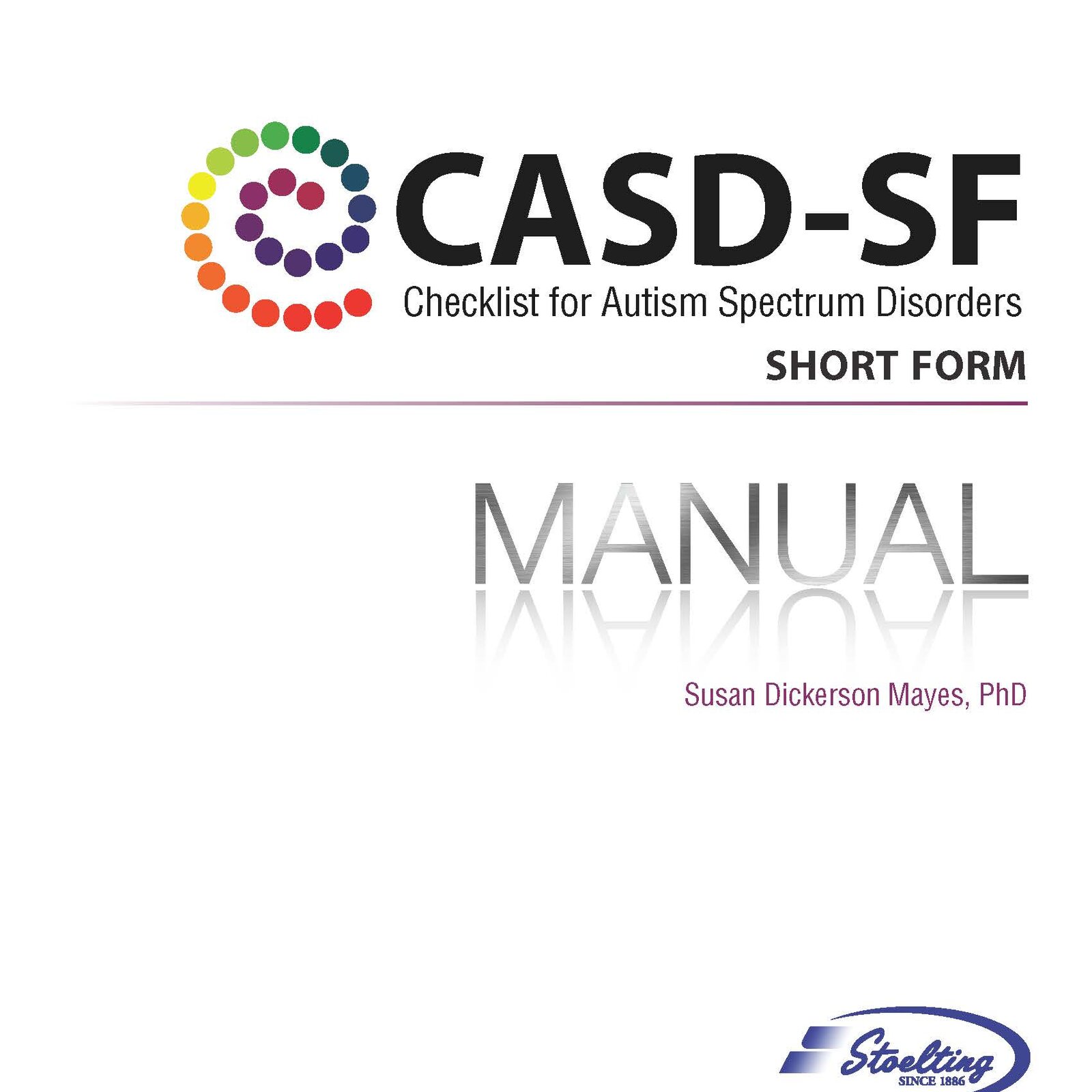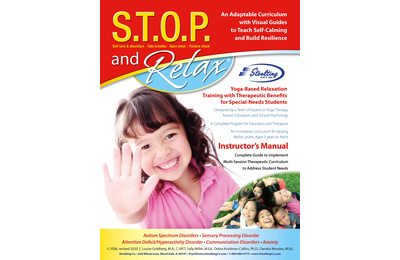Please specify the quantity of product(s).



Checklist for Autism Spectrum Disorder, Short Form (CASD-SF)
| Item | Product | Price | QTY |
|---|---|---|---|
| 34210S | CASD-SF Kit | $110.00 | |
| 34210-SR | CASD-SF Interview Forms, Pk/25 | $36.00 | |
| 34210-SM | CASD-SF Manual | $85.00 | |
| 34210-SRE | CASD-SF Interview Forms-Spanish, Pk/25 | $33.00 |
Checklist for Autism Spectrum Disorder- Short Form (CASD-SF), published by Stoelting, is able to diagnose autism and differentiate autism from other disorders with tremendous accuracy, despite only requiring a short interview, using DSM 5 criteria.
A short version of the CASD useful for screening purposes with diagnostic accuracy comparable to CASD.
Susan D. Mayes, PhD
- Age Range: 1-17 years
- Administration Time: 5 minutes
Briefer and easier for clinicians, parents and teachers to complete than the CASD, the CASD-SF, published by Stoelting, still includes symptoms in each of the DSM-5 Autism Spectrum Disorder symptom domains.
The CASD-Short Form was created to provide a brief instrument equally effective in diagnosing autism as the 30-item CASD. The 30 CASD items were statistically analyzed to determine the smallest subset of items that differentiated between children with autism and children with other disorders (3-17 years of age) with 100% accuracy. Six CASD items were statistically identified that differentiated children with and without autism. The CASD-SF cut-off score determined from this sample (3 or higher indicating autism) was cross-validated on an independent sample of children with autism and other clinical disorders (1 to 17 years), resulting in 98.5% accuracy in diagnosing children with and without autism. The CASD-SF has excellent diagnostic agreement (95% or greater) with the CASD full form, Autism Diagnostic Interview-Revised and Childhood Autism Rating Scale. The CASD-SF includes symptoms in each of the DSM-5 Autism Spectrum Disorder symptom domains and is consistent with the DSM-5 view of autism as a single spectrum disorder.
Need for the CASD-SF
Autism diagnostic instruments that are valid, brief, cost-effective, and easy to administer and score are needed in order to facilitate the early identification and treatment of children with autism and to facilitate research. Time- consuming, complex, and expensive diagnostic tools are available but are impractical for routine clinical practice and clinical research. The CASD and CASD-SF fill the need for a simple and accurate diagnostic instrument. The 30-item CASD covers a broad array of autistic symptoms to conduct a thorough autism diagnostic evaluation and gain a comprehensive understanding of the child’s symptoms. It provides a structured format to facilitate diagnostic feedback to the parents, report writing, and the development of intervention goals and strategies. The CASD-SF offers an even quicker assessment that streamlines diagnosis by assessing the six critical CASD items most accurate in differentiating children with and without autism.
The CASD-SF has been validated on individuals 1-17 years of age at all levels of intelligence (profound intellectual disability to gifted IQ). Because of its brevity and simplicity, all children who are referred for a diagnostic evaluation for autism or developmental, behavioral, or other mental health concerns could be administered the CASD-SF to rule-in or rule-out autism. Likewise, all young children receiving early intervention services could be screened for possible autism with the CASD-SF. This is especially important for young children for whom a diagnosis of autism is often missed because autism was not assessed. Research shows that a majority of children with autism also meet diagnostic criteria for ADHD, and children with autism are often initially diagnosed only with ADHD and much later, the presence of autism is recognized (Mayes, Calhoun, Mayes, & Molitoris, 2012). A clinician should never stop with an ADHD diagnosis without considering other disorders that are highly comorbid with ADHD, like autism. Many young children with developmental or language delays referred to early intervention or developmental clinics have autism, which all too often is missed. Studies demonstrate that autism is common in children who have apraxia of speech (Tierney et al., 2015), and that most children with autism have normal motor and delayed speech milestones (Mayes & Calhoun, 1999, 2001, 2011). The CASD-SF offers a valid and quick means of helping to ensure that autism is not missed in children referred for developmental or behavioral problems and that the child is not deprived of evidence-based autism interventions, particularly applied behavior analysis (ABA), which can be accessed by an autism diagnosis. Studies show greater increases in IQ, developmental progress, adaptive behavior, and attendance in regular education and greater reduction in autistic symptoms in children receiving intensive ABA than in those who don’t.
Six CASD items were statistically identified to discriminate between children with Autism Spectrum Disorder, and those with ADHD, with 100 percent accuracy. The CASD-SF has excellent diagnostic agreement with the CASD, ADI-R and CARS.
The CASD-SF Kit (34210S) includes 25 Interview Forms and a Manual.
CASD Training Video Sample- Interview
Literature Review
Falkmer, T., Anderson, K., Falkmer, M., & Horlin, C. (2013). Diagnostic procedures in autism spectrum disorders: A systematic literature review. European Child & Adolescent Psychiatry, 22(6), 329-40.
- Review of instruments for diagnosing ASD, with CASD comparing favorably
Mayes, S. D., Black, A., & Tierney, C. D. (2013). DSM-5 under-identifies PDDNOS: Diagnostic agreement between the DSM-5, DSM-IV, and checklist for autism spectrum disorder. Research in Autism Spectrum Disorders, 7(2), 298-306.
- Suggestions for improving predictive power of DSM-5
Mayes, S. D., Calhoun, S. L., Mayes, R. D., & Molitoris, S. (2012). Autism and ADHD: Overlapping and discriminating symptoms. Research in Autism Spectrum Disorders, 6(1), 277-285.
- Ability of CASD to differentiate autism and Attention Deficit Hyperactivity Disorder
Mayes, S. D., Calhoun, S. L., Murray, M. J., Morrow, J. D., Yurich, K. K., L., . . . Petersen, C. (2009). Comparison of scores on the checklist for autism spectrum disorder, childhood autism rating scale, and gilliam asperger's disorder scale for children with low functioning autism, high functioning autism, asperger's disorder, ADHD, and typical development. Journal of Autism and Developmental Disorders, 39(12), 1682-93.
- High diagnostic agreement between CASD and GADS
Murray, M. J., Mayes, S. D., & Smith, L. A. (2011). Brief report: Excellent agreement between two brief autism scales (checklist for autism spectrum disorder and social responsiveness scale) completed independently by parents and the autism diagnostic interview-revised. Journal of Autism and Developmental Disorders, 41(11), 1586-90.
- High reliability of CASD and SRS
Smith, I. C., Reichow, B., & Volkmar, F. R. (2015). The effects of DSM-5 criteria on number of individuals diagnosed with autism spectrum disorder: A systematic review. Journal of Autism and Developmental Disorders, 45(8), 2541-2552.
- Use of CASD to compare percent of people with autism diagnosis under DSM-5 criteria
Tierney, C., Mayes, S., Lohs, S. R., Black, A., Gisin, E., & Veglia, M. (2015). How valid is the checklist for autism spectrum disorder when a child has apraxia of speech? Journal of Developmental and Behavioral Pediatrics, 36(8), 569-n/a.
- CASD valid for diagnosing those without speech with autism
